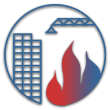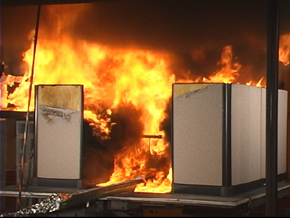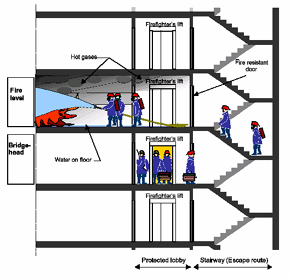|
|
|
|
|
|
|
|
|
|
|
|
 |
 |
 |
 |
|||||||
|
|
||||||||||
 |
 |
 |
 |
 |
 |
 |
 |
|||
BFRL Strategic Goal
Measurement Science for Disaster-Resilient Structures and Communities
Photograph of the burning of a typical office workstation.
Firefighters elevators provide access to fires on upper floors of tall buildings.
What is the problem? Natural and technological disasters cause an estimated $55 billion in average annual costs (and growing), with single catastrophes like Hurricane Katrina and future “Kobe” earthquakes causing mega-losses exceeding $100 billion. Existing extreme load-related prescriptive requirements of building codes, standards, and practices stifle design and construction innovation and increase construction costs. The risk in large disaster-prone regions of the Nation is substantially greater now than ever before due to the combined effects of development and population growth. As noted by the National Science and Technology Council, “…a primary focus on response and recovery is an impractical and inefficient strategy for dealing with [natural disasters]. Instead, communities must break the cycle of destruction and recovery by enhancing disaster resilience.”1
The link between basic research and building codes, standards, and practices is weak. Further, the measurement science is lacking to: (1) predict structural performance to failure under extreme loading conditions: (2) predict disaster resilience at the community scale; (3) assess and evaluate the ability of existing structures to withstand extreme loads; (4) design new buildings and retrofit existing buildings using cost-effective, performance-based methods; and (5) derive lessons learned from disasters and failures involving structures.
Why is it hard to solve? The natural processes that produce risks in the built environment and the information relative to those risks for use by design professionals, standards developers, and emergency planners are not well understood. Cost-effective mitigation strategies that improve the performance of structural systems are complex, often lying outside the breadth of the prescriptive procedures that dominate building codes, standards, and practices. Methods for transferring basic research results into practice are limited. The engineering community lacks standard methods of predicting, evaluating, and assessing the disaster resilience of structures as they respond to extreme loads. Communities lack standard methods of assessing disaster resilience at the community scale for use in making disaster preparedness and mitigation decisions.
The disaster resistance of structures and disaster resilience of communities is determined by building codes, standards, and practices used when structures were built – most older structures have only minimal resistance. Most codes, standards, and practices are highly prescriptive, simplified, and inconsistent with respect to risk – stifling innovation and increasing cost. There is a lack of validated tools and metrics to evaluate structural and community performance, as well as the risks to which they are exposed – the lack of accurate models increases conservatism and decreases cost-effectiveness. Codes and standards are developed by private sector organizations that often lack the resources needed to develop the technical bases to improve them. Practices, codes, and standards used in design, construction, and retrofit are based largely on research performed or supported by the government.
Why BFRL? Measurement Science for Disaster-Resilient Structures and Communities supports the BFRL mission of promoting U.S. innovation and competitiveness by anticipating and meeting the measurement science, standards, and technology needs of the U.S. building and fire safety industries in ways that enhance economic security and improve the quality of life. This program fulfills a national knowledge transfer role that is not well-supported by a fragmented U.S. construction industry. The program supports the BFRL core competency in performance, reliability, and resilience of structures and communities under extreme loads. Finally, NIST has statutory responsibilities including: the Fire Prevention and Control act (1974); the National Earthquake Hazards Reduction Program Reauthorization Act (1977, amended 2004); the National Windstorm Impact Reduction Act (2004); and the National Construction Safety Team Act (2002).
[1] National Science and Technology Council, Grand Challenges for Disaster Reduction – A Report of the Subcommittee on Disaster Reduction, June 2005.
Component Programs:
National Earthquake Hazards Reduction Program
Structural Performance under Multi-Hazards
Contact:
Steve Cauffman
(301) 975-6051
stephen.cauffman@nist.gov
|
Privacy Policy / Security Notice / Accessibility | Disclaimer | FOIA NIST is an agency of the U.S. Department of Commerce |

|
Last updated: 1/15/2008

